Red Scorpionfish, Pontinus furcirhinus
 Red Scorpionfish, Pontinus furcirhinus. Fish caught from coastal waters off Loreto, Baja California Sur, June 2017. Length: 23 cm (9.1 inches). Catch, photograph, and identification courtesy of Chris Wheaton, Fullerton, California.
Red Scorpionfish, Pontinus furcirhinus. Fish caught from coastal waters off Loreto, Baja California Sur, June 2017. Length: 23 cm (9.1 inches). Catch, photograph, and identification courtesy of Chris Wheaton, Fullerton, California.
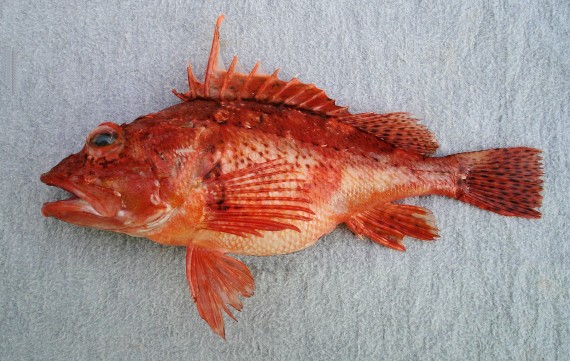
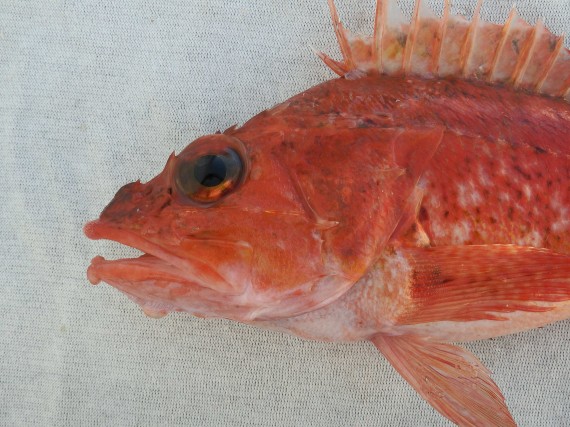 Red Scorpionfish, Pontinus furcirhinus. Fish caught from coastal waters off Point Palmilla, Baja California Sur, May 2014. Length: 25 cm (9.8 inches).
Red Scorpionfish, Pontinus furcirhinus. Fish caught from coastal waters off Point Palmilla, Baja California Sur, May 2014. Length: 25 cm (9.8 inches).
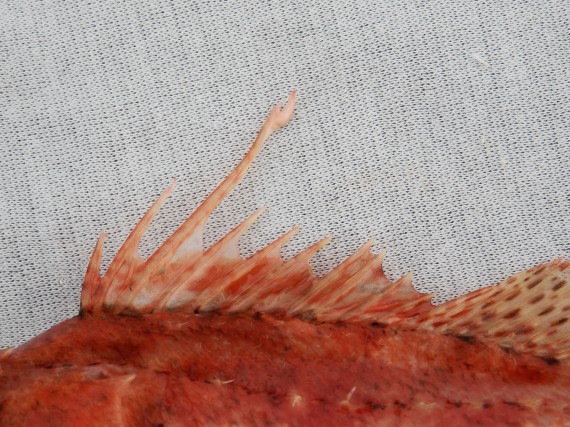
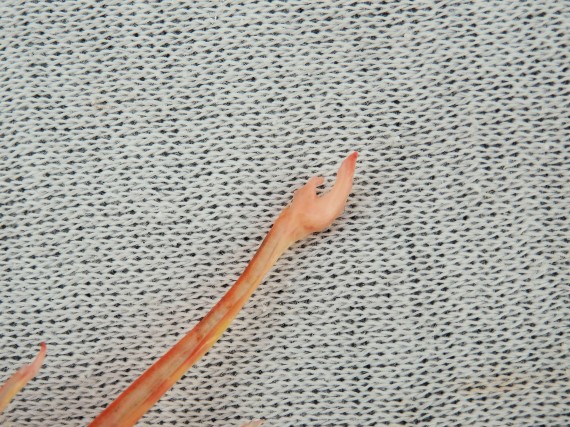 Red Scorpionfish, Pontinus furcirhinus, Dorsal Fin. A most unusual “flag” tipped third dorsal spine. Purpose is unknown – mating, bait attraction, current detection?
Red Scorpionfish, Pontinus furcirhinus, Dorsal Fin. A most unusual “flag” tipped third dorsal spine. Purpose is unknown – mating, bait attraction, current detection?
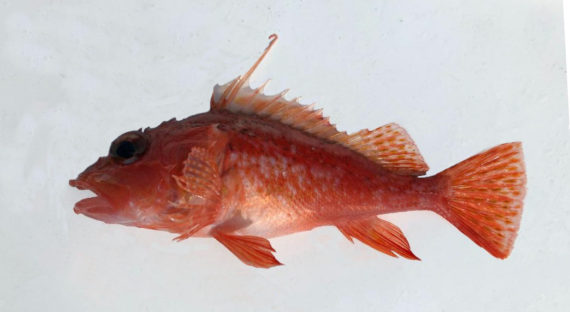 Red Scorpionfish, Pontinus furcirhinus. Fish caught from coastal waters off Punta Arena, Baja California Sur, July 2019. Length: 26 cm (10.2 inches). Catch and photograph courtesy of Steve Wozniak, Alamo, California.
Red Scorpionfish, Pontinus furcirhinus. Fish caught from coastal waters off Punta Arena, Baja California Sur, July 2019. Length: 26 cm (10.2 inches). Catch and photograph courtesy of Steve Wozniak, Alamo, California.
The Red Scorpionfish, Pontinus furcirhinus, is a member of the Rockfish and Scorpionfish or Scorpaenidae Family, and known in Mexico as lapón rojo. Globally, there are twenty-one species in the genus Pontinus, of which seven are found in Mexican waters, three in the Atlantic and four in the Pacific Ocean.
The Red Scorpionfish has a relatively slender compressed body with a depth that is 31% to 38% of standard length; they become wider as they mature. They are various shades of red with white mottling and dark brown and olive spotting on their upper body. Their caudal fin and the posterior portion of their dorsal fin are heavily spotted with small dark rectangular spots. Their head is enlarged, compressed, bulbous, and very bony with numerous spines. They have large eyes and a few have slender and pointed eye cirri. They lack the “pits” before and after the eyes found in most other Scorpionfish. Their uppermost gill cover spine is the longest. Their anal fin has 3 spines, the second being the longest and stoutest, and 5 or 6 rays; their caudal fin is square with a ragged margin; their dorsal fin has 12 spines, the third being much longer than the others (the key to identification), and 8 or 9 rays; and their pectoral fins have 17 to 19 rays. They have 15 to 20 gill rakers. Their lateral line is complete and prominent. Their bodies are covered with rough scales.
The Red Scorpionfish are found at depths between 46 m (150 feet) and 695 m (2,280 feet) over both hard and soft bottoms. They reach a maximum of 33 cm (13 inches) in length. As of January 1, 2024, the International Game Fish Association world record stood at 0.57 kg (1 lb 4 oz) with the fish caught by my good friend Chris Wheaton in coastal waters off Loreto, Baja California Sur, June 2021. The Red Scorpionfish is poorly studied with very limited information available about their lifestyle and behavioral patterns including specific details on age, growth, longevity, movement patterns, diet, habitat use, and reproduction.
The Red Scorpionfish is a resident of Mexican waters of the Pacific Ocean but have a limited distribution being found from Magdalena Bay, Baja California Sur, southward along the southwest coast of Baja, in the southern two-thirds of the Sea of Cortez, and along the coast of the mainland south to Guatemala.
The Red Scorpionfish is very similar in appearance to the Peruvian Scorpionfish, Scorpaena afuerae and the Speckled Scorpionfish, Pontinus sierra, however only the Red Scorpionfish has an elongated third dorsal spine. The Red Scorpionfish is very similar in appearance to the Peruvian Scorpionfish, Scorpaena afuerae and the Speckled Scorpionfish, Pontinus sierra, however only the Red Scorpionfish has an elongated third dorsal spine. Note: the presence of a long third dorsal spine is always consistent with a fish being a Red Scorpionfish. However, Dr. Ben Victor, Coralreeffish.com has done the DNA analysis on a couple of my red colored scorpionfish that do not have an elongated third dorsal spine and found that they are actually Pontinus furcirhinus. Dr. Victor feels that a heavily spotted caudal fin is an additional indicator to correctly identify Red Scorpionfish. Historically I have encountered Red Scorpionfish with short third dorsal spines approximately one in a thousand.
From a conservation perspective the Red Scorpionfish is currently considered to be of Least Concern with stable, widely distributed populations. They are small in stature and difficult to handle but are retained and consumed by subsistence fishermen. They are normally a “catch and release” but seldom return to the deep. Sea Birds approach and give Red Scorpionfish a great deal of respect. Caution: As with all Scorpionfish, the Red Scorpionfish should be treated as “hazardous” and released as soon as possible, being careful not to allow their poisonous spines to penetrate the skin. Even the starving seabirds won’t touch a released Red Scorpionfish – they know better!